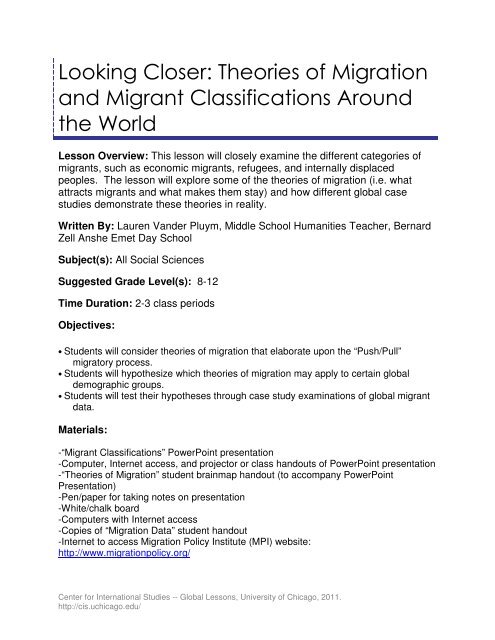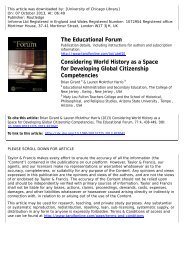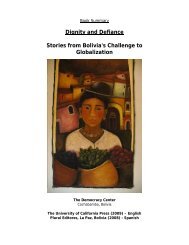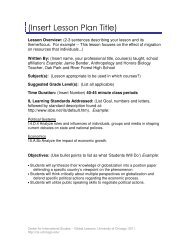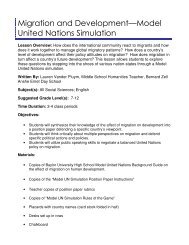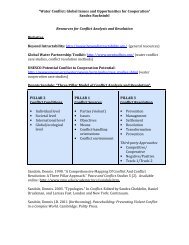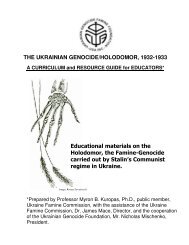Theories of Migration and Migrant Classifications Around the World
Theories of Migration and Migrant Classifications Around the World
Theories of Migration and Migrant Classifications Around the World
You also want an ePaper? Increase the reach of your titles
YUMPU automatically turns print PDFs into web optimized ePapers that Google loves.
Looking Closer: <strong>Theories</strong> <strong>of</strong> <strong>Migration</strong><strong>and</strong> <strong>Migrant</strong> <strong>Classifications</strong> <strong>Around</strong><strong>the</strong> <strong>World</strong>Lesson Overview: This lesson will closely examine <strong>the</strong> different categories <strong>of</strong>migrants, such as economic migrants, refugees, <strong>and</strong> internally displacedpeoples. The lesson will explore some <strong>of</strong> <strong>the</strong> <strong>the</strong>ories <strong>of</strong> migration (i.e. whatattracts migrants <strong>and</strong> what makes <strong>the</strong>m stay) <strong>and</strong> how different global casestudies demonstrate <strong>the</strong>se <strong>the</strong>ories in reality.Written By: Lauren V<strong>and</strong>er Pluym, Middle School Humanities Teacher, BernardZell Anshe Emet Day SchoolSubject(s): All Social SciencesSuggested Grade Level(s): 8-12Time Duration: 2-3 class periodsObjectives:• Students will consider <strong>the</strong>ories <strong>of</strong> migration that elaborate upon <strong>the</strong> “Push/Pull”migratory process.• Students will hypo<strong>the</strong>size which <strong>the</strong>ories <strong>of</strong> migration may apply to certain globaldemographic groups.• Students will test <strong>the</strong>ir hypo<strong>the</strong>ses through case study examinations <strong>of</strong> global migrantdata.Materials:-“<strong>Migrant</strong> <strong>Classifications</strong>” PowerPoint presentation-Computer, Internet access, <strong>and</strong> projector or class h<strong>and</strong>outs <strong>of</strong> PowerPoint presentation-“<strong>Theories</strong> <strong>of</strong> <strong>Migration</strong>” student brainmap h<strong>and</strong>out (to accompany PowerPointPresentation)-Pen/paper for taking notes on presentation-White/chalk board-Computers with Internet access-Copies <strong>of</strong> “<strong>Migration</strong> Data” student h<strong>and</strong>out-Internet to access <strong>Migration</strong> Policy Institute (MPI) website:http://www.migrationpolicy.org/Center for International Studies -- Global Lessons, University <strong>of</strong> Chicago, 2011.http://cis.uchicago.edu/
Optional Background Information for Teacher: All <strong>of</strong> <strong>the</strong> following videolectures were originally presented at <strong>the</strong> University <strong>of</strong> Chicago 2011 University <strong>of</strong>Chicago Summer Teacher Institute, “<strong>Migration</strong>: Causes <strong>and</strong> Consequences.” Allvideos can be found at this link:http://cis.uchicago.edu/summerinstitute/2011/resources/• "Economic Effects <strong>of</strong> Immigration: Lessons from <strong>the</strong> Chicago LaborMarket,” presented by Virginia Parks, Ph.D., School <strong>of</strong> Social ServiceAdministration, University <strong>of</strong> Chicago.• "International <strong>Migration</strong>: Trends, Issues, <strong>and</strong> Future Prospects," presentedby Aaron Terrazas, Policy Analyst, <strong>Migration</strong> Policy Institute.• "Organizations, Scenes, <strong>and</strong> Local Contexts,” presented by Terry NicholsClark, Pr<strong>of</strong>essor, Department <strong>of</strong> Sociology, University <strong>of</strong> Chicago.• "Seeking Sanctuary: Asylum <strong>and</strong> <strong>the</strong> Politics <strong>of</strong> Compassion in Irel<strong>and</strong>,”presented by Anwen Tormey Dept. <strong>of</strong> Anthropology, University <strong>of</strong> Chicago.Activities <strong>and</strong> Procedures:1. If students are not familiar with <strong>the</strong> basic “Push/Pull Factor” explanation <strong>of</strong> <strong>the</strong>migratory process, briefly explain this <strong>the</strong>ory <strong>and</strong> ask students to think about differentsituations in which this might be true. **For details, see step 5 in <strong>the</strong> “<strong>Migration</strong> 101”K-12 lesson at http://cis.uchicago.edu/summerinstitute/2011/resources/**• Push/Pull Factors: “Push” factors are things that drive people AWAY from aplace, while “Pull” factors are things that DRAW people IN to a place.2. (Pass out copies <strong>of</strong> “<strong>Theories</strong> <strong>of</strong> <strong>Migration</strong>” student worksheet. They will be takingnotes on <strong>the</strong> PowerPoint presentation on <strong>the</strong> brainmap.) For students who havealready discussed <strong>the</strong> “Push/Pull” process, simply review <strong>the</strong> definition <strong>and</strong> someexamples, which can be found on slide one <strong>of</strong> this lesson’s accompanying <strong>the</strong>PowerPoint presentation titled, “<strong>Migrant</strong> <strong>Classifications</strong>.”3. Ask students to think about whe<strong>the</strong>r <strong>the</strong> traditional “Push/Pull” model could possiblyhave any shortcomings. To prompt students, consider <strong>the</strong> following questions:• What does this definition tell you about <strong>the</strong> motivations <strong>of</strong> migrants? What doesit NOT tell you?o These are humans we are talking about—does this definition tell youanything about thoughts or feelings?• Are people always going to fall into just one <strong>of</strong> <strong>the</strong>se categories? Or could it beboth push <strong>and</strong> pull at <strong>the</strong> same time?Center for International Studies -- Global Lessons, University <strong>of</strong> Chicago, 2011.http://cis.uchicago.edu/
o For example, someone may be “pushed” out <strong>of</strong> <strong>the</strong>ir homel<strong>and</strong> due toscarce job opportunities, while at <strong>the</strong> same time, <strong>the</strong>y may be “pulled” out<strong>of</strong> <strong>the</strong>ir homel<strong>and</strong> toward a country with better opportunities.4. After students have discussed some <strong>of</strong> <strong>the</strong>ir own thinking, move on to slide 2 toreiterate some <strong>of</strong> <strong>the</strong> problems that modern migration scholars find with <strong>the</strong> push/pullexplanation.5. Explain to students that many <strong>the</strong>orists have attempted to improve upon <strong>the</strong>traditional “push/pull” model in order to help researchers more fully underst<strong>and</strong> migrantmotivations. Move on through <strong>the</strong> presentation to slides 4-7 to show students some <strong>of</strong><strong>the</strong> different <strong>the</strong>ories that exist. Ask <strong>the</strong>m to think carefully about <strong>the</strong> advantages <strong>and</strong>shortcomings <strong>of</strong> all <strong>of</strong> <strong>the</strong>se explanations:• To help guide your teaching narrative:o Slide 5: The neo-classical <strong>the</strong>ory depends on <strong>the</strong> idea that we arealways going to choose what is in our best interest economically. Thinkabout it—if you were skilled in building space shuttles, would you want tolive in a country without a space program? More than likely, you would goto a place where your skills could actually be used <strong>and</strong> you would be paidwell for <strong>the</strong>m. Can you think <strong>of</strong> any problems with <strong>the</strong> neo-classical <strong>the</strong>ory?• It is based solely on economic factors, when people <strong>of</strong>tenmove for a number <strong>of</strong> o<strong>the</strong>r non-economic reasons• It ignores human attachment to a “home” <strong>and</strong> socialpreferences. People do not always want to move because<strong>the</strong> destination in question may not suit <strong>the</strong>ir social needs,despite this destination having more job opportunities.• Many people do not have <strong>the</strong> resources to move to moredeveloped economies <strong>and</strong> must stay in lower wage markets.o Slide 6: The Dual Labor Market Theory depends on <strong>the</strong> idea thatmigrants will ALWAYS be needed to fill <strong>the</strong> jobs that <strong>the</strong> native populationWILL NOT take. For example, many college-educated Americans wouldnot even look twice at a job that did not require an advanced degree, suchas a job in housecleaning. Yet, <strong>the</strong>y underst<strong>and</strong> that this job is necessaryto society, which creates a NEED for immigrants to fill those positions. Any problems with this <strong>the</strong>ory?• In times <strong>of</strong> economic crisis (like right now in <strong>the</strong> U.S.), manyhighly-skilled people may be FORCED to take secondarysector jobs, diminishing <strong>the</strong> need for migrants.• It also has many <strong>of</strong> <strong>the</strong> same problems as <strong>the</strong> neo-classical<strong>the</strong>ory, in that it is based solely on economics <strong>and</strong> ignoreso<strong>the</strong>r human needs.o Slide 7: <strong>World</strong> Systems Theory depends mainly on <strong>the</strong> complex idea <strong>of</strong>globalization—<strong>the</strong> world’s economy becoming more <strong>and</strong> more intertwined.This <strong>the</strong>ory proposes that as business flows across national borders, sowill people.Center for International Studies -- Global Lessons, University <strong>of</strong> Chicago, 2011.http://cis.uchicago.edu/
Any problems with <strong>the</strong> neo-classical <strong>the</strong>ory?• Though it considers more than <strong>the</strong> o<strong>the</strong>r <strong>the</strong>ories, it alsoignores some <strong>of</strong> <strong>the</strong> same social <strong>and</strong> political reasons whypeople may or may not migrate.o Slide 8: Amenities Theory Now what about some <strong>of</strong> <strong>the</strong> social reasonswhy people might move? According to University <strong>of</strong> Chicago Pr<strong>of</strong>essorTerry Nichols Clark, people mainly move to satisfy <strong>the</strong>ir need for personalpreferences <strong>and</strong> entertainment. For example, where would you ra<strong>the</strong>rlive: a town that has a great job for you but has absolutely nothing to do,or a city that has a mediocre job for you <strong>and</strong> has <strong>the</strong> best shopping,restaurants, <strong>and</strong> <strong>the</strong>aters in <strong>the</strong> world? For most, <strong>the</strong> choice is simple. The chart on slide 8 shows what Pr<strong>of</strong>essor Clark sees as <strong>the</strong> mainreasons for human movement. He claims that investment inbusiness, education, <strong>and</strong> amenities will lead to economic growth,which <strong>the</strong>n attracts more people to a certain location. Problems? This <strong>the</strong>ory does take into account personalpreferences, unlike <strong>the</strong> o<strong>the</strong>rs, but it still ignores some <strong>of</strong> <strong>the</strong> “push”factors, like violence <strong>and</strong> political conflict.• Additionally, do all people in <strong>the</strong> world have <strong>the</strong>resources to move according to <strong>the</strong>ir social <strong>and</strong>entertainment preferences? Think about countries o<strong>the</strong>rthan <strong>the</strong> U.S. that may not have as many economicresources.6. After going through slides 4-8, move on to slide 9 <strong>and</strong> ask students: What modelor<strong>the</strong>ory do you think best explains why <strong>the</strong> average American migrates?• More than likely students will say <strong>the</strong> last “Amenities” model because <strong>of</strong> our highlevel <strong>of</strong> economic development.• Why might Americans be more able to move based on personal tastes <strong>and</strong>preferences?o Most Americans are considered to be “middle class” in that <strong>the</strong>y have <strong>the</strong>economic resources to allow <strong>the</strong>m <strong>the</strong> freedom <strong>of</strong> CHOICE in where <strong>the</strong>ymove. They are not necessarily constrained by economic factors alone.o Americans have <strong>the</strong> political freedom to move based on preference. Wedo not typically face retribution from <strong>the</strong> government or <strong>the</strong> threat <strong>of</strong>violence when choosing a location.• Ask students whe<strong>the</strong>r <strong>the</strong>y think <strong>the</strong> “Amenities” model would be true <strong>of</strong> Sub-Saharan Africa, where people <strong>of</strong>ten live on less than two dollars a day <strong>and</strong>citizens are faced with ongoing violence.o More than likely, students will point out that it may be much more difficultto have options <strong>and</strong> preferences about where you move because <strong>of</strong>economic <strong>and</strong> political restraints.Center for International Studies -- Global Lessons, University <strong>of</strong> Chicago, 2011.http://cis.uchicago.edu/
7. Move to slide 10. Research shows that <strong>the</strong> poorest <strong>of</strong> <strong>the</strong> world’s poor DO NOTmigrate, or do so to a much lesser degree than richer <strong>and</strong> more developedcountries.• Examine <strong>the</strong> chart from <strong>the</strong> <strong>Migration</strong> Policy Institute (MPI)• Guide students in reading <strong>the</strong> data, which shows that <strong>the</strong> most impoverishedpeople ei<strong>the</strong>r move to OTHER impoverished countries, or simply do not move atall.8. Point out to students that this data goes against <strong>the</strong> <strong>the</strong>oretical assumption thatpeople will always move to better economic opportunities. Sometimes people justsimply lack <strong>the</strong> resources to leave <strong>the</strong>ir current situations.9. Up to this point, students have considered <strong>the</strong> economic <strong>and</strong> some social reasonsfor migration. Ask students to think about o<strong>the</strong>r explanations for migration that gobeyond economic factors. What else might “push” someone to move, even when<strong>the</strong>y do not have <strong>the</strong> economic interest in doing so? Students might point out thatmany people move due to political <strong>and</strong>/or social unrest within <strong>the</strong>ir countries, or <strong>the</strong>ymay be fleeing disasters <strong>of</strong> some kind.10. Move to slide 11 <strong>and</strong> discuss <strong>the</strong> different classifications <strong>of</strong> involuntarymigration—refugees, asylum-seekers, <strong>and</strong> IDPs. It is important to explain to studentsthat <strong>of</strong>tentimes, <strong>the</strong>se classifications <strong>of</strong> migrants lack <strong>the</strong> economic resources to move,but are forced to do so, despite <strong>the</strong>ir financial circumstances.11. Now that students have discussed all <strong>the</strong> various <strong>the</strong>ories <strong>of</strong> migration <strong>and</strong> <strong>the</strong>different types <strong>of</strong> migrants that exist, explain that you are going to put a “human face” onthis information by looking at <strong>the</strong> migration data from countries around <strong>the</strong> world. As aclass you will be asking:• What are <strong>the</strong> primary reasons why migrants leave <strong>and</strong> come to this country?• What <strong>the</strong>ories <strong>of</strong> migration best apply to this country’s situation?• What “classification” do migrants in this country have? (i.e. economic migrant,refugee, IDP)12. Explain to students that <strong>the</strong>y will be using data compiled by <strong>the</strong> <strong>Migration</strong> PolicyInstitute (MPI) to determine <strong>the</strong> answers to <strong>the</strong>se questions. As a class, you will shareyour information to get a better picture <strong>of</strong> why <strong>and</strong> how people are migrating in certainparts <strong>of</strong> <strong>the</strong> world.13. Teachers can ei<strong>the</strong>r have students work individually or in groups to find <strong>the</strong> data ona certain country using <strong>the</strong> following URL:http://www.migrationinformation.org/Resources/**NOTE: When assigning countries, it is essential to have a good balancebetween regions <strong>of</strong> <strong>the</strong> world to best show <strong>the</strong> variety <strong>of</strong> migratory factors.Center for International Studies -- Global Lessons, University <strong>of</strong> Chicago, 2011.http://cis.uchicago.edu/
14. Give each student or group a copy <strong>of</strong> <strong>the</strong> “<strong>Migration</strong> Data from <strong>Around</strong> <strong>the</strong> <strong>World</strong>”student h<strong>and</strong>out. Students will need Internet access in order to compile data. This canbe done during class, or as a homework assignment.15. Have students present <strong>the</strong>ir findings after <strong>the</strong>y have finished <strong>the</strong>ir research. Itwould be best to present by region.16. As students present, take notes on <strong>the</strong> board <strong>of</strong> <strong>the</strong> primary factors for migration ineach region studied. To wrap up, consider <strong>the</strong> following discussion questions:• What similarities <strong>and</strong> differences do you see across <strong>the</strong> regions <strong>of</strong> <strong>the</strong> world?• Take a look at <strong>the</strong> regions in <strong>the</strong> nor<strong>the</strong>rn hemisphere (<strong>the</strong> Americas, Europe)—why might <strong>the</strong>se countries have more choice in migration, whereas countries in<strong>the</strong> South tend to have more refugees <strong>and</strong> IDPs?• After looking at all <strong>of</strong> this, what can we determine about <strong>the</strong> validity <strong>of</strong> <strong>the</strong> existing<strong>the</strong>ories <strong>of</strong> migration? Are <strong>the</strong>y adequate in explaining every part <strong>of</strong> <strong>the</strong> world?Why or why not?Assessments:• Collect student brainmaps on <strong>the</strong> <strong>the</strong>ories <strong>of</strong> migration to check for comprehension.See teacher narrative above for brainmap details.• Collect research <strong>and</strong> assess <strong>the</strong> level <strong>of</strong> analysis for each question.• Students should also be assessed on level <strong>of</strong> participation <strong>and</strong> presentation <strong>of</strong>research.Adaptations:All assessment measures can be adapted to fit your population. Some students may begraded simply on how much <strong>the</strong>ir thinking grew, <strong>the</strong>ir willingness to participate, <strong>and</strong>helpfulness to o<strong>the</strong>rs. Additionally, teachers may need to define certain vocabularyterms <strong>and</strong> use simpler language in explaining <strong>the</strong>ories to lower grades.Center for International Studies -- Global Lessons, University <strong>of</strong> Chicago, 2011.http://cis.uchicago.edu/
<strong>Migration</strong> Data from <strong>Around</strong> <strong>the</strong> <strong>World</strong>Student H<strong>and</strong>outName: _____________________________Assigned Country <strong>and</strong> Region: ________________________________________________Directions:1. Go to <strong>the</strong> following URL: http://www.migrationinformation.org/Resources/2. Click on your assigned country <strong>and</strong> record its name <strong>and</strong> region at <strong>the</strong> top <strong>of</strong> this worksheet.3. Consider <strong>the</strong> questions below using <strong>the</strong> data found on your country.Record <strong>the</strong> following data: Population Population growth rate Net migration rateWhat could <strong>the</strong>se statistics possibly tell you about migration to <strong>and</strong> from your country?Now click on <strong>the</strong> link to <strong>the</strong> first story on your country (located next to <strong>the</strong> country map).Read <strong>the</strong> story <strong>and</strong> answer <strong>the</strong> following to <strong>the</strong> best <strong>of</strong> your ability:4. What are <strong>the</strong> main groups coming to your country? What are <strong>the</strong> reasons for doing so?(Economic, social, political?) Has this changed at all over time?Center for International Studies -- Global Lessons, University <strong>of</strong> Chicago, 2011.http://cis.uchicago.edu/
5. What are <strong>the</strong> main groups leaving your country? What are <strong>the</strong>ir reasons for doing so?(Economic, social, political?) Has this changed at all over time?6. Does your country host any refugees or IDPs? Or does your country create refugees too<strong>the</strong>r countries? Explain.7. After reading about your country’s history <strong>of</strong> migration, which <strong>the</strong>ory discussed in class doyou think best applies to your country today? (Look back at your notes for help). Explain.Center for International Studies -- Global Lessons, University <strong>of</strong> Chicago, 2011.http://cis.uchicago.edu/


